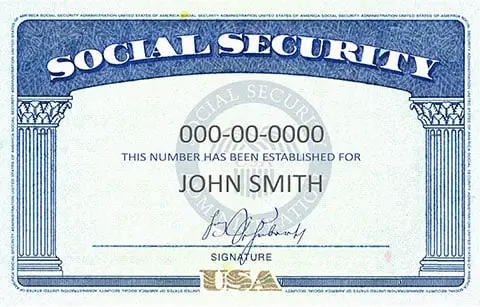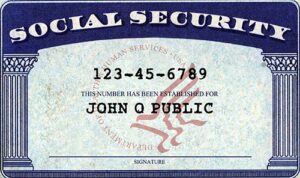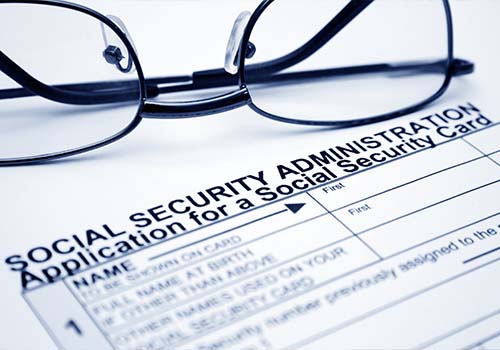Have you ever looked at your Social Security number and wondered exactly how the Social Security Administration assigns numbers? There is a method to that nine-digit number madness, which is not as mysterious as it might seem.
The prefix, or first three digits, of your number, is assigned based on the location where you were born or lived at the time your number was issued. So, contrary to what some people might believe, they are not simply assigned in numerical order. Keep reading if you want to learn more about how the prefixes are assigned.
Finding Your Social Security Number (SSN) Prefix By State
Up until 1972, Social Security numbers were issued by the SSA’s local field offices. The prefix used in the number could identify which local SSA office issued it. Today, numbers are issued by the Social Security Administration’s central office.
The Social Security number prefix still holds some value, though. It identifies the state where the person was born or lived at the time the number was issued, so sorting Social Security numbers by state is easy. Most Social Security numbers are requested upon the birth of a child in the United States, so your prefix identifies the state in which you were born. If you are an immigrant or requested an SSN later in life, the prefix shows which state you resided in at the time of your SSN issuance.
Prefix Assignment to States & Territories
As you will see in the table below, some states have multiple prefixes associated with their location. In addition, some prefixes are reserved for future use and are not currently associated with any state. Likewise, a valid SSN will never begin with the prefix 000 but will contain one of the area numbers in the chart below. In addition to states, U.S. territories like Guam, Puerto Rico, the U.S. Virgin Islands, American Samoa, and the Philippine Islands all have unique identifying prefixes.
Full Table of Prefix Information by State
| Number Prefix | State Issued |
|---|---|
| 001-003 | New Hampshire |
| 004-007 | Maine |
| 008-009 | Vermont |
| 010-034 | Massachusetts |
| 035-039 | Rhode Island |
| 040-049 | Connecticut |
| 050-134 | New York |
| 135-158 | New Jersey |
| 159-211 | Pennsylvania |
| 212-220 | Maryland |
| 221-222 | Delaware |
| 223-231 & 691-699 | Virginia |
| 232-236 | West Virginia |
| 232 & 237-246 & 681-690 | North Carolina |
| 247-251 & 654-658 | South Carolina |
| 252-260 & 667-675 | Georgia |
| 261-267 & 589-595 & 765-772 | Florida |
| 268-302 | Ohio |
| 303-317 | Indiana |
| 318-361 | Illinois |
| 362-386 | Michigan |
| 387-399 | Wisconsin |
| 400-407 | Kentucky |
| 408-415 & 756-763 | Tennessee |
| 416-424 | Alabama |
| 425-428 & 587-588 & 752-755 | Mississippi |
| 429-432 & 676-679 | Arkansas |
| 433-439 & 659-665 | Louisiana |
| 440-448 | Oklahoma |
| 449-467 & 627-645 | Texas |
| 468-477 | Minnesota |
| 478-485 | Iowa |
| 486-500 | Missouri |
| 501-502 | North Dakota |
| 503-504 | South Dakota |
| 505-508 | Nebraska |
| 508-515 | Kansas |
| 516-517 | Montana |
| 518-519 | Idaho |
| 520 | Wyoming |
| 521-524 & 650-653 | Colorado |
| 525 & 585 & 648-649 | New Mexico |
| 526-527 & 600-601 & 764-765 | Arizona |
| 528-529 & 646-647 | Utah |
| 530 & 680 | Nevada |
| 531-539 | Washington |
| 540-544 | Oregon |
| 545-573 & 602-626 | California |
| 574 | Alaska |
| 575-576 & 750-751 | Hawaii |
| 577-579 | District of Columbia |
| 580 | Virgin Islands |
| 580-584 & 596-599 | Puerto Rico |
| 586 | Guam, American Samoa & Philippines |
| 700-728 | Railroad |
| 729-733 | Enumeration of Entry |
KEY TAKEAWAYS
- Social Security numbers were established as part of the Social Security Act of 1935 and were initially only used to track earnings history.
- SSN consists of three parts: an Area Number, a Group Number, and a Serial Number. Beginning in 2011, the SSA started randomly assigning Social Security numbers.
What Do The Last Two Sets Of Social Security Numbers Mean?
Social Security numbers consist of three sets of numbers. The first set, as described above, is the Area Number, which denotes the state in which the card was issued. For most people, this will be the state they were born in.
Group Number
Following the Area Number, the next two digits form the Group Number. This portion of the SSN was initially used for administrative purposes, such as processing applications and organizing records. The Group Number was not directly tied to specific information about the SSN holder.
Serial Number
The final four digits of the SSN comprise the Serial Number. These numbers were assigned sequentially within each Area Number and Group Number combination. In the past, SSNs were issued in a predictable pattern, with lower serial numbers assigned earlier than higher ones. However, the sequential assignment is no longer strictly maintained due to changes in the issuance process and an increased population.
Must read articles related to Social Security Numbers
- What is a Social Security Award Letter…how do you get a copy?
- What is my Social Security number…how do I find it?
- Can your Social Security number be suspended?
- Fourteen ways to protect your Social Security number.
- Three easy steps to apply for Social Security benefits.
Social Security Number Randomization
How is a SSN generated? On June 25, 2011, the Social Security Administration began utilizing a new Social Security Number (SSN) randomization process. The SSA implemented this new system to enhance the security of SSNs and extend their availability in every state.
Features of the new SSN Generator (Randomization)
1) Eliminates Geographical Significance:
- Before randomization, the first three digits of the SSN (area number) were tied to the location where the SSN was issued. Now, area numbers are assigned randomly, removing any connection to geography.
2) Prevent Predictability:
- The randomized assignment of numbers makes it harder to guess an SSN using public information, enhancing security against identity theft. It also means that family members will not have similar numbers.
3) Expands Number Pool:
- Randomization allows the use of previously unassigned area numbers, increasing the pool of available SSNs
TIP
A Social Security number is an essential part of your identity. You should protect your number from fraudulent activity. It forms the foundation for tracking your credit, work, and earnings history. It is also necessary for filing taxes.
Primary Purpose of Social Security Numbers
The original purpose of a Social Security number (SSN) was to track work and earnings history to determine Social Security retirement benefits. However, your SSN is now used in many more instances, such as getting loans, opening bank and investment accounts, healthcare, credit cards, etc.
You will need a Social Security number to:
As you can see, having a Social Security number is essential. If you lose your Social Security card or need a replacement card for another reason, you should immediately contact the SSA.
The Bottom Line
Many people think that a Social Security number is just nine random numbers that the Social Security Administration assigns. However, that is not the case.
Each section of numbers in an SSN has a specific purpose, and before 2011, you can use those numbers to determine information about when and where the number was assigned.
The SSA now uses a randomization process for Social Security Numbers, which makes it impossible to determine the number’s origin just by looking at the digits.
Frequently Asked Questions
The SSA eliminated the geographical significance of the first three digits of the SSN, referred to as the area number, by no longer allocating the area numbers for assignment to individuals in specific states.
The significance of the highest group number (the fourth and fifth digits of the SSN) for validation purposes was also eliminated. Randomization also introduced previously unassigned area numbers for assignment, excluding area numbers 000, 666, and 900-999.
No, the SSN prefix only indicates the issuing state or territory and does not provide information about the SSN holder’s current residence.
The SSN prefix does not directly indicate the year of issuance. However, certain patterns existed in the past, such as lower numbers being assigned earlier, which can give a rough idea of the time period.
A Social Security number is probably the most used piece of identifying information in the United States, and you can find your SSN in several places. It is used for identification in everything from banking and financial transactions to applying for retirement or disability benefits.
You use your SSN to file tax returns, apply for loans or credit cards, and track your employment history. Without a valid SSN, you would have a difficult time living in today’s world. Your employer will also need your Social Security number to track your work credits and pay your Medicare and Social Security taxes.
You can find a Social Security Administration office near you by using our SSA office locator and searching for your closest location.






